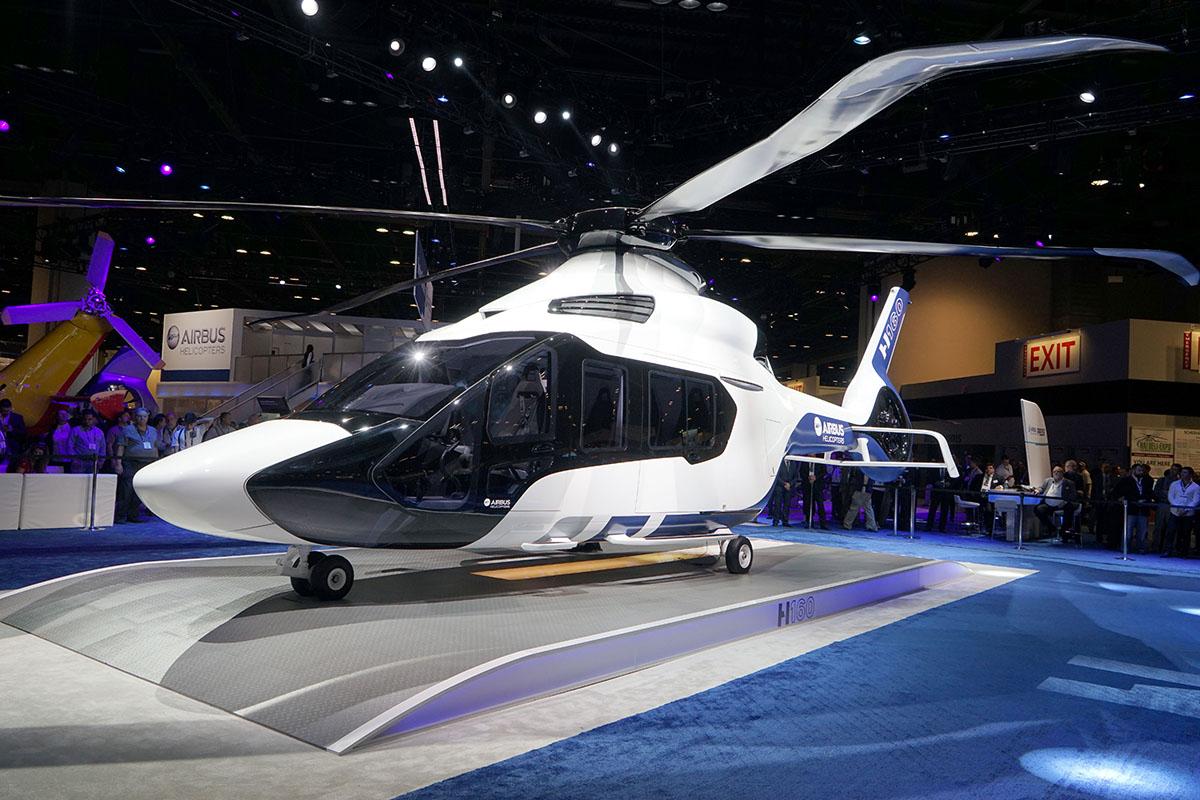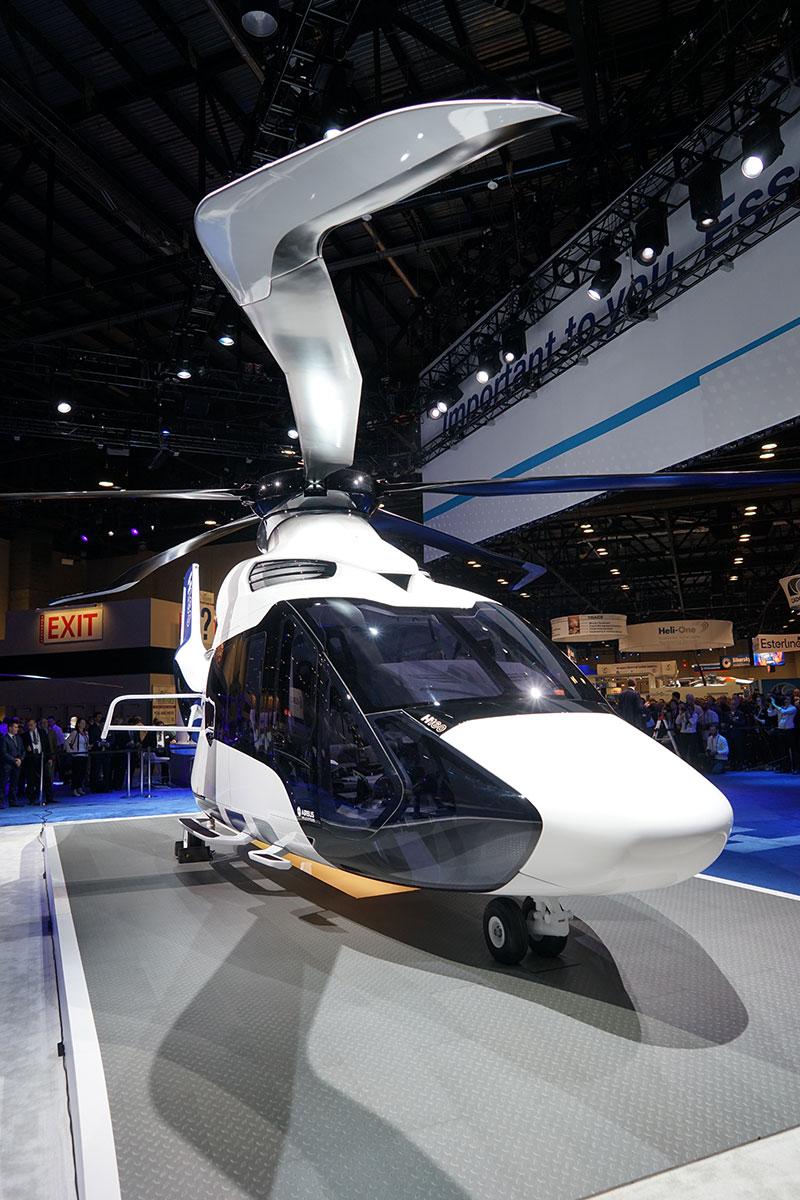http://www.ainonline.com/aviation-news/business-aviation/2015-03-03/airbus-helicopters-unveils-h160-medium-twin
Most composite materials for the airframe are similar to those found on the military NH90. Airbus expects a reduction in maintenance needs and “maximized occupant safety.” An innovation on the rotor hub is the use of thermoplastics for lower-cost manufacturing, reduced weight and, above all, damage tolerance–a crack will propagate very slowly. Airbus Helicopters designers believe the hub has the greatest thickness ever of a thermoplastic part in aerospace. Conventional rotor hubs are metallic, although other Airbus Helicopter models such as the AStar are equipped with composite hubs, which use glass fiber and thermoset resin. The H160’s hub is made from carbon fiber with a thermoplastic resin.
On February 12, the first prototype airframe was still in the paint shop. It was incomplete, missing its main rotor and engines, among other components. Three prototypes–dubbed PT1, PT2 and PT3–will be joined by a pre-production (PS01) aircraft in flight tests. Gensse will be the test pilot aboard PT1, along with two flight test engineers. An EC155 demonstrator has been helping with development of the Blue Edge blades, the stabilizer and the canted tail rotor and will keep supporting the H160 program.
Airbus Helicopters is also introducing comprehensive new ground-test facilities to facilitate development of the H160. These include a dynamic integration testbed and a system integration testbed–respectively the “dynamic helicopter zero” (DHC0) and the “system helicopter zero” (SHC0).
The goal of DHC0 is to ensure the maturity of dynamic systems. These include the flight control system, rotors, drive shafts, gearboxes, engines, etc. “The more we find with DHC0, the easier the flight tests,” said Gary Clark, head of vehicle test and integration. DHC0 also can be seen as a means for fast testing, as a modification is easier to implement on the testbed than it is on a prototype. It is to start running this month and will also be used during the flight test and certification phases. “The first run of DHC0 is as important as the first flight of PT1,” Fujarski emphasized.
All individual components have already been tested. DHC0 is all about integration, Clark said. The program includes engine controls, acoustics, thermal and maintainability trials, among others.
A critical subassembly of DHC0 is the main gearbox, and Airbus claims to have learned lessons from the EC225’s problems. The H160’s main gearbox is a clean-sheet design with a new approach to lubrication redundancy. Two independent systems run 100 percent of the time. In case the main lubrication system fails, the backup provides enough lubrication for about five hours. The backup system has no cooling circuit, being entirely internal. In case both systems fail, the run-dry capability has already been demonstrated to be greater than 30 minutes. This demonstrated duration is expected to be increased through more trials. The rotation speed of the gears has been reduced, too, thus reducing the thermal build-up rate.
For electric and hydraulic systems, SHC0 runs in parallel to DHC0. It is all about anticipating problems for certification and maturity, said Eric Jansonnie, head of system test. Some components are simulated, such as the engines: for example, electric motors enable the generators to run. SHC0 entered into service in January.
Thanks to the new facility, issues have already been found, such as how two of the systems are integrating. Some design teams that were previously distant have been gathered around SHC0 to foster better cooperation. SHC0 is also an important tool–nearly a flight simulator–for flight deck development.
Another tool is the digital mockup. A notable use is to involve customers in the maintainability aspects. For example, retractable footsteps have been integrated in the side fuselage for easier access to the engines. A virtual mechanic could “test” them, thus pre-validating the design.
The MSG-3 process, already used on the EC175 to optimize the maintenance program, is this time involving customers at an earlier stage. Technical documents will be based on images (still or animated) with accompanying text–as opposed to text with accompanying illustrations. A health and usage monitoring system (HUMS) will be standard on the H160.
Airbus wants the H160 to be “a mature aircraft from day one.” The target is to reach a 95 percent availability rate from the first entry into service, up from the EC175’s 90 percent. Operational availability had already been the focus of many efforts on the EC175 program.
The design of the H160 has not been only about technical details, but style has been fostered, too. Guillaume Chielens, who was formerly employed by the PSA Peugeot Citroën automotive group, heads the style bureau. “A driver was the history of the company, but we’ve also had to show it is a new aircraft and give it a strong identity, which could make it as recognizable as a Dauphin,” Chielens explained.
The nose of the H160 creates a link with the EC175, he added. The black “mask” on the livery was created to contribute to modernity. Some lines could still evolve. Flight tests will help designers choose between various fairings at the rotor hub level, for example.
Debates with the rest of the design engineers have been numerous but common ground could often be found, such as with aerodynamicists, Chielens said. “But we can't measure the added value of style,” he pointed out.
Airbus Helicopters plans to begin taking orders for the H160 next year.











